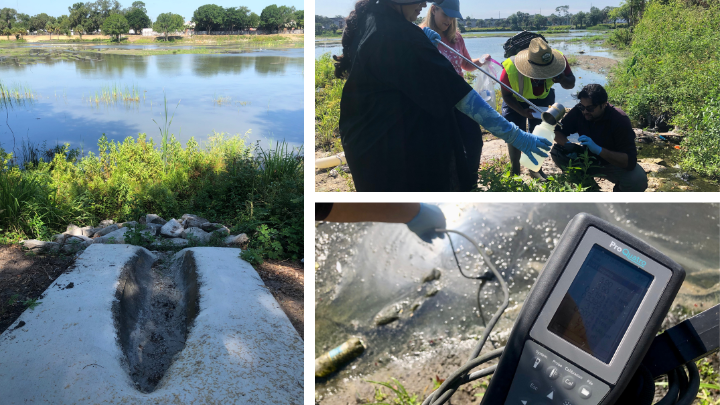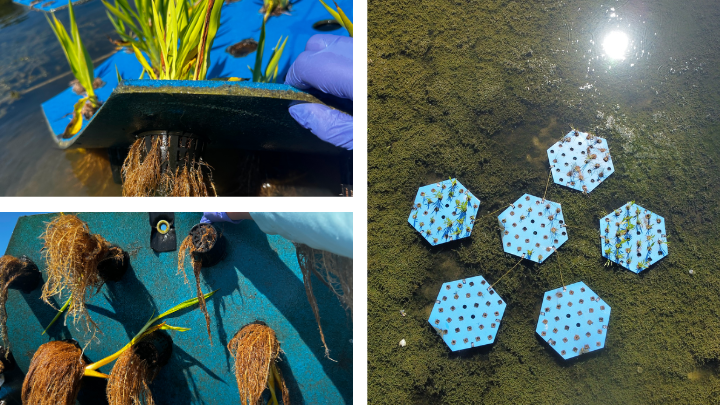Zombie Ponds to Living Community Ponds
Project Information
Project Goals & Tasks
Project Goals
With the unique challenges facing the University Area Community and its local stormwater system; Aarans pond presents an opportunity to address novel stormwater issues while raising community awareness and value for stormwater through collaborative design. At the same time, presenting the opportunity to explore how biochar amended bioinfiltration and floating wetland systems can aid the redesign of an urban stormwater pond while seeking to reduce Total Nitrogen (TN) and Total Phosophorus (TP) concentrations. The overall goal of this project is to turn zombie ponds to living community ponds using collaborative actions and novel adsorbent-amended bio-infiltration and floating wetland systems.

Bio-Infiltration Systems

Credit: Oldcastle Infrastructure
Bio-infiltration systems (i.e., rain gardens, bioretention, bioswales) are promising green infrastructure stormwater management approaches. These systems use engineered filter media within shallow depressions to treat stormwater. A properly designed bio-infiltration system also allows clean water to trickle down to the groundwater table, thereby helping to recharge the groundwater. Bio-infiltration systems can be planted to improve pollutant removal and provide the community with a beautiful, landscaped area. However, most bio-infiltration systems are not designed to remove nutrients, so nitrogen and phosphorus can still pollute stormwater ponds.

Our research on bio-infiltration systems focuses on adding very low cost materials, like biochar and wood chips, to the bio-infiltration bed to improve the removal of nutrients. Biochar is formed by burning wood chips or other wastes in a low oxygen environment. It forms a material that is similar to charcoal. Biochar and wood chips adsorb pollutants and also provides a habitat for beneficial bacteria that degrade pollutants. During a storm, the biochar can capture the pollutants. In between the storm the beneficial microbes can biodegrade the pollutants. Our research has shown that this strategy can improve the removal of nitrogen and pathogens. We are currently testing this strategy for removing oil and grease that is often present in parking lot runoff.
Additional Information and Resources
Floating Wetlands

What Is a Floating Wetland System?
Floating Wetland systems are a form of green, (or non grey) infrastructure that aids in improving the water quality of stormwater ponds. A floating wetland consists of buoyant materials that form a platform or mat, and a collection of plants that are typically anchored to the mat with a pot or surface of material that the plants root into and grow. These platforms resemble tiny islands and sit on the surface of the pond. In practice, a floating wetland system helps to decrease the concentration of pollution as the wetland plants feed off pollutants such as nutrients or heavy metals and break down other forms of pollutants that enter the pond through runoff. Floating wetlands can be uniquely useful because features of their design can be changed to fit the location. This can be done through the inclusion of local plants, scaling the size of the system to the pond, and with the freedom to construct or move wetlands to key areas of a pond with anchors.

Floating Wetland Research at USF
In collaboration with researchers from the University of Florida, Civil and environmental engineers at USF are conducting research on floating wetland systems and exploring the possible benefits of floating wetland systems to stormwater systems in the University Area. By installing test systems in Aarans pond this project is interested in monitoring the effect that different plants in combination with special potting materials have on nutrient removal. Of particular note is the exploration of biochar within these systems. Biochar is a porous carbon-based material formed from burning organic material like plants in a low oxygen environment. This material has been of key interest for its high adsorption property that can aid floating wetland systems further in nutrient removal.
